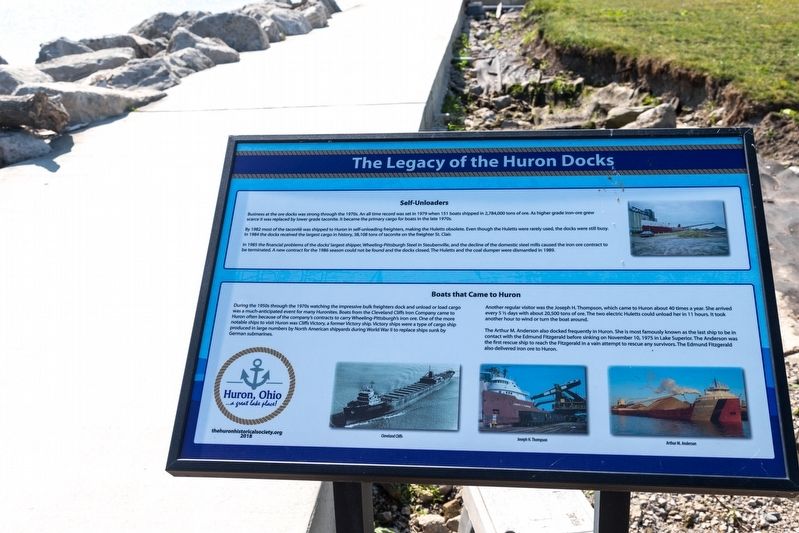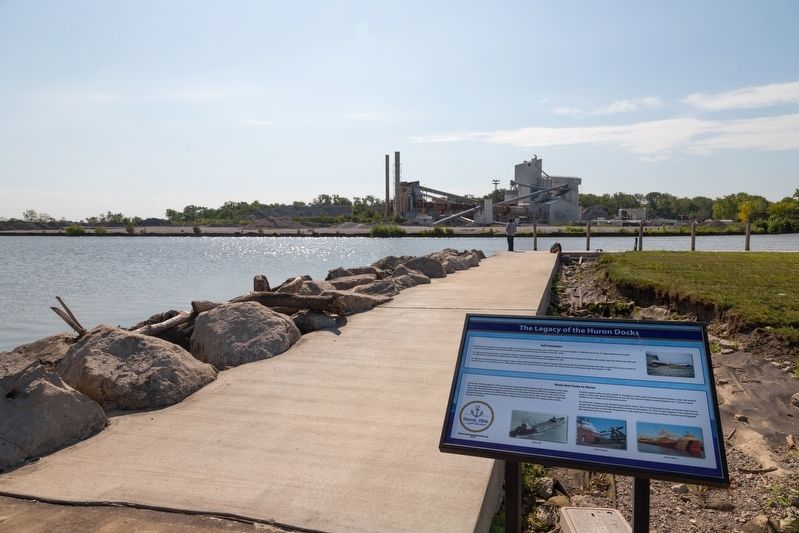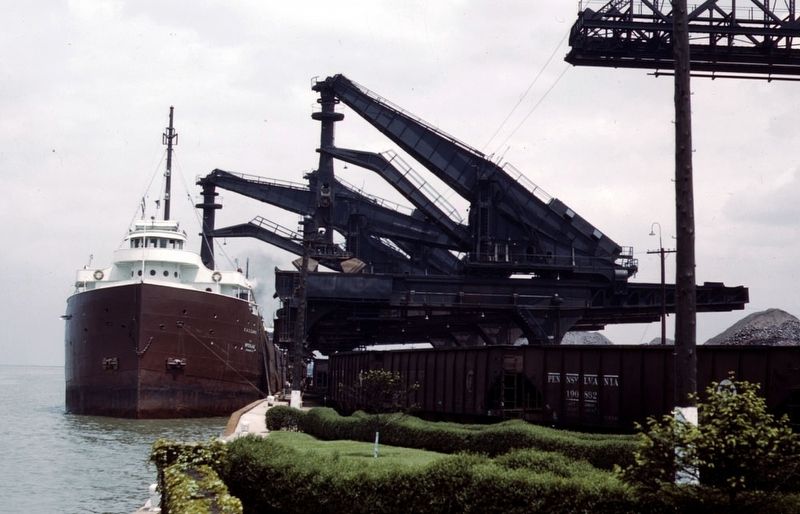Huron in Erie County, Ohio — The American Midwest (Great Lakes)
Legacy of the Huron Docks
Self-Unloaders / Boats that Came to Huron
Inscription.
Self-Unloaders. Business at the ore docks was strong through the 1970s. An all time record was set in 1979 when 151 boats shipped in 2,784,000 tons of ore. As higher grade iron-ore grew scarce it was replaced by lower grade taconite. It became the primary cargo for boats in the late 1970s.
By 1982 most of the taconite was shipped to Huron in self-unloading freighters, making the Huletts obsolete. Even though the Huletts were rarely used, the docks were still busy. In 1984 the docks received the largest cargo in history, 38,108 tons of taconite on the freighter St. Clair.
In 1985 the financial problems of the docks’ largest shipper, Wheeling-Pittsburgh Steel in Steubenville, and the decline of the domestic steel mills caused the iron ore contract to be terminated. A new contract for the 1986 season could not be found and the docks closed. The Huletts and the coal dumper were dismantled in 1989.
Boats that Came to Huron. During the 1950s through the 1970s watching the impressive bulk freighters dock and unload or load cargo was a much-anticipated event for many Huronites. Boats from the Cleveland Cliffs Iron Company came to Huron often because of the company’s contracts to carry Wheeling-Pittsburgh’s iron ore. One of the more notable ships to visit Huron was Cliffs Victory, a former Victory ship. Victory ships were a type of cargo ship produced in large numbers by North American shipyards during World War II to replace ships sunk by German submarines.
Another regular visitor was the Joseph H. Thompson, which came to Huron about 40 times a year. She arrived every 5½ days with about 20,500 tons of ore. The two electric Huletts could unload her in 11 hours. It took another hour to wind or turn the boat around.
The Arthur M. Anderson also docked frequently in Huron. She is most famously known as the last ship to be in contact with the Edmund Fitzgerald before sinking on November 10, 1975 in Lake Superior. The Anderson was the first rescue ship to reach the Fitzgerald in a vain attempt to rescue any survivors. The Edmund Fitzgerald also delivered iron ore to Huron.
Erected 2018 by the Huron Historical Society thehuronhistoricalsociety.org.
Topics. This historical marker is listed in these topic lists: Industry & Commerce • Waterways & Vessels. A significant historical date for this entry is November 10, 1975.
Location. 41° 23.883′ N, 82° 33.02′ W. Marker is in Huron, Ohio, in Erie County. Marker can be reached from Main Street north of Wall Street. It is just beyond the parking area for the Huron Docks and Lighthouse facing the dock walkway. Touch for map. Marker is in this post office area: Huron OH 44839, United States of America. Touch for directions.
Other nearby markers. At least 8 other markers are within walking distance of this marker. Huron Lighthouses / Huron’s Maritime History (within shouting distance of this marker); John Baptiste Flemmond (about 500 feet away, measured in a direct line); a different marker also named The Legacy of the Huron Docks (about 600 feet away); a different marker also named Legacy of the Huron Docks (approx. 0.2 miles away); Huron / Erie County (approx. 0.2 miles away); Christ Episcopal Church (approx. ¼ mile away); a different marker also named The Legacy of the Huron Docks (approx. 0.3 miles away); The Wright House and the Underground Railroad/Old Main Street (approx. 0.3 miles away). Touch for a list and map of all markers in Huron.
More about this marker. Taconite is a source of iron ore from Minnesota, an iron-bearing sedimentary rock, in which the iron minerals are interlayered with quartz, chert, or carbonate.
Huletts were ore unloaders that were widely used on the Great Lakes of North America. They were unsuited to tidewater ports because they could not easily adjust for rising and falling tides.
Credits. This page was last revised on May 25, 2020. It was originally submitted on November 7, 2019, by J. J. Prats of Powell, Ohio. This page has been viewed 557 times since then and 233 times this year. Photos: 1, 2, 3. submitted on November 7, 2019, by J. J. Prats of Powell, Ohio.


